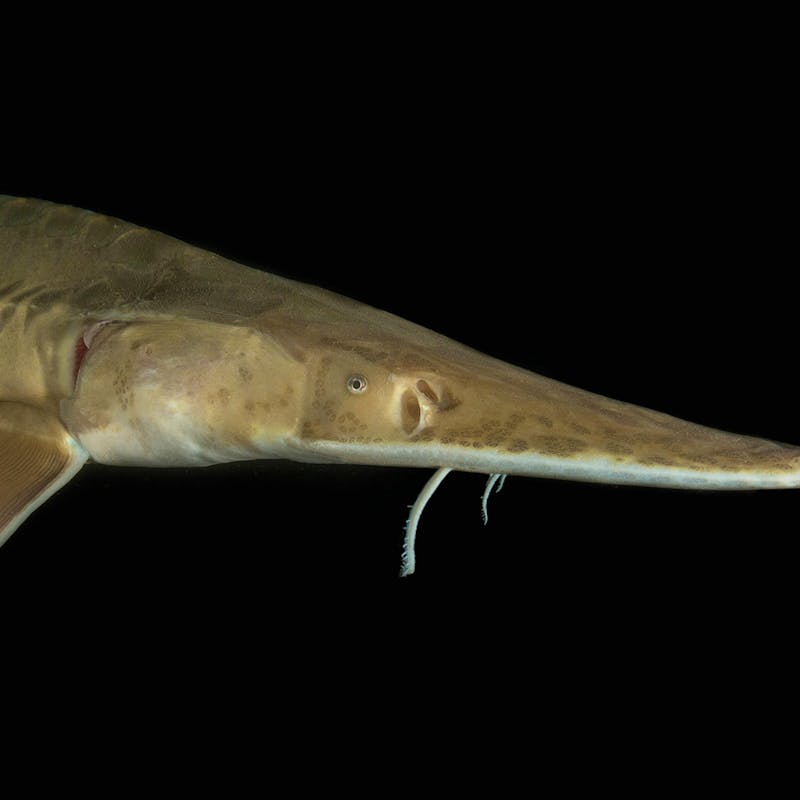Montana is the fourth largest state in the United States, spanning 559 miles east to west, and is known for its diverse landscapes. There are the Rocky Mountains in the west and the Great Plains in the east. Its foothills, badlands, rivers, lakes and prairies support an amazing diversity of wildlife.
Scurrying through the long grasses, swimming up streams and climbing the slopes are a diversity of animals. Many of these animals are having to adapt to changing conditions resulting from habitat loss due to human development and agriculture, climate change, and varying levels of acceptance and protection. 18 species currently listed under the Endangered Species Act can be found in Montana.
Scale down this blog to read about some of these listed animals including the grizzly bear, black-footed ferret, wolverine and pallid sturgeon.
Grizzly Bear
Grizzly bears once ranged across western North America, including throughout all of Montana. As European settlers expanded westward, however, they hunted these bears to near-extinction. By 1975, there were fewer than 1,000 grizzlies in the lower 48. Today, there are four mostly isolated populations of grizzly bears in Wyoming, Montana, Idaho and Washington. In Montana, estimates range between 800 and 1900 grizzly bears left in the four occupied recovery areas. Two recovery areas, the Bitterroot (Idaho and Montana) and the North Cascades (Washington) have no viable populations.
Grizzly bears promote healthy ecosystems as they disperse nutrients and seeds. They promote plant growth when they dig for roots, bugs and small mammals. Grizzly bears are opportunistic omnivores, meaning they will eat what’s available to them including plants and meat. In Montana, the bears will eat dead elk and bison, grasses, dandelions, horsetail and ants. In the fall, nuts from the ESA-listed, climate-imperiled white bark pine can be a significant source of food for some bears. Grizzlies in the lower 48 have made great progress from the brink of extinction, but still face major challenges from lack of connectivity between their habitats and risks from human-bear conflict – risks that can be mitigated through education, non-lethal tools, and responsible conflict management.
Black-Footed Ferret
Black-footed ferrets were thought totally extinct by the 1970s due to widespread human destruction of prairie dogs and habitat created by them, and the arrival of exotic diseases, including sylvatic plague in the 1900s. Today, thanks to black-footed ferret captive breeding and reintroduction programs, additional recovery efforts, plague mitigation, and tools to help landowners and prairie dogs better coexist, there are around 400 wild black-footed ferrets.
Prairie dogs make up more than 90% of black-footed ferrets’ diet. Prairie dog burrows also provide a necessary habitat for black-footed ferrets. In addition to providing shelter, mother ferrets give birth and begin raising their kits in the underground tunnels.
Black-footed ferrets were first reintroduced to Fort Belknap Reservation in north-central Montana in 1997, but a plague epidemic decimated the ferret and prairie dog populations. Once prairie dog populations had rebuilt, ferrets were reintroduced again in 2013. The prairie dog colonies were also dusted to prevent plague in the future, a measure taken at various black-footed ferret recovery sites.
Wolverine
A rare sight, wolverines are mostly solitary and occupy huge, remote territories that can range from 40 to over 350 square miles. In the lower 48, wolverines are found throughout portions of the Northern Cascades in Washington and the northern Rocky Mountains in Montana, Idaho and Wyoming. These voracious scavengers are difficult to study and count, but it’s estimated there are about 300 wolverines left in the lower 48 today.
Wolverines depend on areas with deep snow for their dens, to raise their young and store food in. A warming climate means an increasingly uncertain future for these and other snowpack-dependent species. Additionally, these large weasels are at risk from traps, human disturbance, habitat fragmentation, and extremely low population numbers resulting in low genetic diversity. Thankfully, wolverines were listed as threatened under the ESA in November 2023 giving them long overdue protections.
Pallid Sturgeon
These ‘dinosaur fish’ once swam freely in rivers from Montana to New Orleans for millions of years. Pallid sturgeon are one of the largest freshwater fish in North America, weighing up to 80 pounds and reaching up to 6 feet long. They are found in the Missouri River and in many major tributaries including the Yellowstone. About 100 wild Pallid Sturgeon remain in the upper Missouri River system, including in Montana and North Dakota, above Lake Sakakawea.
Mature pallid sturgeon swim hundreds of miles upstream to congregate and spawn. Newly hatched sturgeons, called larvae, drift with the river’s current for up to two weeks before they can swim and feed on their own. Unfortunately, dams built in the 1900s disrupted the Missouri River and cut off access to much of the sturgeon’s spawning grounds. Additionally, many eggs and larva die in man-made and oxygen-deprived reservoirs.
You can Help!
Defenders is working to protect and restore all four of these imperiled species. You can join us! Learn more about threatened and endangered species in your state and share their stories with friends, family and followers. Raise your voice, write letters to your representatives and cast your vote in favor of protecting animals and their habitats. And, if you are able, support organizations, like Defenders, that are fighting to strengthen and protect the ESA.
Join Defenders on a virtual summer road trip! Learn more about what we’re doing in Montana and check out the interactive map to see what other animals we work on around the U.S.















Follow Defenders of Wildlife
facebook bluesky twitter instagram youtube tiktok threads linkedin